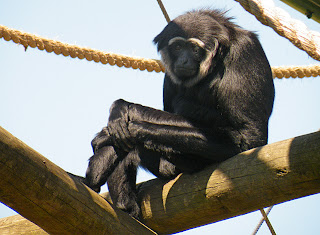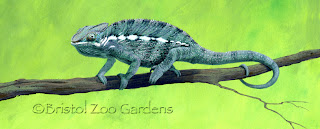We had a Bank Holiday this week so I wasn't in work on Monday.
Tuesday 7th
When I got in this morning the first thing I noticed was that scaffolding was going up at the Round Aviary. I can just see this aviary through the bamboo stand just outside one of the windows of the studio. Work had been scheduled on this aviary as it is being changed from three partitioned enclosures into two and some renovating work will be done in the process; particularly on the old roof which was in need of repair. With all this going on the birds that had been in there would have been moved out into other aviaries either on or off show. After ringing Nigel (Curator of Birds) to see what ID's needed to be changed, taken down or added elsewhere, I popped out to make the adjustments to the signs on several aviaries.
Back in the studio I started on the chameleon. I had already done the drawing and had put a background on a piece of watercolour paper previously. Now all I had to do was paint the animal; I just hoped my feeling that this would be easier than the last one didn't prove wrong. After all, I thought the plated lizard would be fairly straightforward... it was just a series of square shapes after all! How wrong I was there!
I transferred the drawing onto the background and blocked the animal shape in with a base coat. The texture of a chameleon's skin is lots of little bumps... so I basically painted in the colours and pattern of the animal with lots of little dots. I kept an eye on the general configuration of the bump pattern on different parts of the body and replicated that generally. By the end of the day I had got the body done and was quite pleased with the progress.
During the day, for an 'eye break' I went over to the Flamingo Paddock to check on Mister Ruff.... still no sign of ruff development. Nigel had emailed me to say he thought this may be due to there being no females in with him... but he would check to see if any other observations had been made of a similar situation. I did a bit of a google search and was interested to read that ruff are the only birds that have three male strategies for breeding. From what I read, on various specialist sites, it appears that there are three types of males, territorial, non territorial and sneaks or faeders. The dominant males hold territories of leks to entice females onto, the non breeding males come and go as 'satellites' around these leks, looking for opportunities to breed and then the sneaks are basically female impersonators having plumage similar to females and therefore being able to move mostly unchallenged amongst the females and sneaking in a mating when the dominant males are too busy to notice. Research indicates that these positions are born into and cannot change and their ruff colouration coincides with their relative position. Darker ruffs tend to be on dominant territorial males and paler/white ruffs on the satellite males with the faeders not having a ruff at all. But no specific answer to my question about why this male has not developed a ruff, other than a description of non-breeding male colouration. Maybe developing a ruff, for an adult male of breeding age, isn't automatic and it requires a trigger.
Whilst I was out and about I took a few photo's, as it was a gorgeous day weather-wise.
The little egrets were up in their nesting tree, displaying and standing over their stick platforms
Something I hadn't done in a long while was to watch the squirrel monkeys. They are on an island on the lake in the centre of the zoo. This island is crammed with trees shrubs and bushes surrounding their wooden hut. The biggest tree is huge, stretching high above the lake and the squirrel monkeys can go right to the top. They were very active in the trees and standing in a little bay by the meerkats you get a good view at the 'back' of their island. I stood here and watched them running around the tree boughs and crossing from one tree to the next, high up and then scrambling down using the ropes and poles put up to help them access as much of the trees as possible.
This one was high up in the middle part of the biggest tree, peering down at all the activity going on below.
This is Samuel, our male agile gibbon, he's such a handsome lad; he was sat watching the female, Duanne, beneath as she foraged on the floor of their island. They have a huge man-made frame work of poles of varying sizes and ropes to brachiate (swing by their arms) around on. He had just come out of their house and had swung with ease across the ropes from the hut to the framework and then on up through all the ropes and poles, until he came to stop at this point. He glanced down at me before resuming his watch on Duanne and taking in a general glance from his high position around the zoo. I find it frustrating and sad that when some people look at primates and see their downward turned mouths that they assume that is an expression of unhappiness, just like with a human. Most primates have naturally downward turned mouths when their faces are relaxed; they don't smile like us. In fact, a big grin can mean distress or fear for some primates, so we shouldn't assume their facial expressions mean the same as ours.
Wednesday 8th
Back to painting the chameleon for most of the day. Just his tail, legs and head to do today, which I am soooooo relieved and pleased to say went smoothly and satisfactorily. I managed to get him finished, but he has yet to be checked by Tim (Curator of Reptiles and Amphibians); I'll contact Tim next week.
I had my six month assessment today, which is a follow up to the annual main assessments we have each year in the Autumn. As a result of that chat with my boss, Phil (Graphic Design Manager), I will be recording the pattern of ID request submissions. I already record what species I do and have records of this going back to when I started the job in 1995, so this is a handy additional record to make. This is purely to see if there is a general pattern of submissions and when if any groupings occur and the impact that has. This could help me manage the 'to do' list and improve my performance. I went through my email records, ID file records and my species lists to start compiling a list dating from 2010 to present. I have yet to present this information in a table/graph form. When this has been done over a number of years we should be able to see the impact new developments/new staff/animal section changes/my part-time timetable etc has and keep a better eye on the timespan between the request coming in and when the illustration is done.
This week has been short, easy and a lot less stressful. Just what I needed after the last two and that darned plated lizard... will I ever forgive it and be able to look at the sign/animal without having flashbacks of the battle I had!





No comments:
Post a Comment